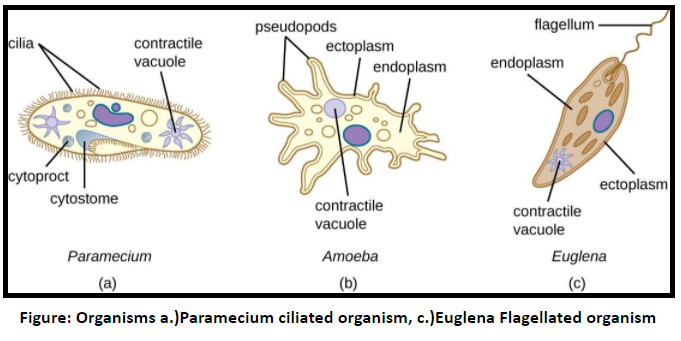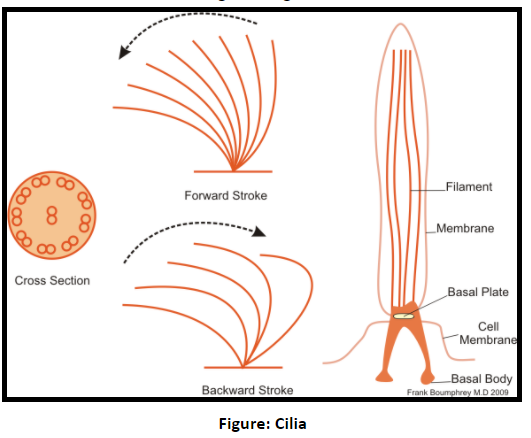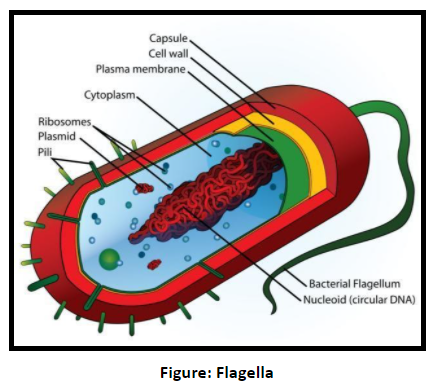
The cell organelle involved in the formation of a flagellum or cilium ….
A. Mitochondria
B. Lysosomes
C. Basal granule
D. Golgi complex
Answer
478.5k+ views
Hint: Cilia and flagella are responsible for movement in the cell. These are mostly found in Eukaryotic cells. These are found outside the cell but originate inside the cell from the basal body.
Complete answer: Cilia and flagella both are thread-like and microscopic structures. 1. These are made by microtubules.
2. The basal body or basal granule is found at the base of cilia and flagella. Both are originated from the basal body.
3. The structure of the Basal body is similar to the centriole.
4. This is present inside the cell under the plasma membrane.
5. The basal body is made by 9 triplet microtubules.
6. Microtubules are made by specific proteins.
7. From the basal body, cilia, and flagella both are formed.

Additional information: Cilia and flagella both are structurally similar.
Both are made by microtubules which are found in 9+2 arrangement 9 microtubules are peripheral, made by tubulin protein and 2 microtubules are central, made by dyeing protein. These are found in both eukaryotic and prokaryotic cells.
Cilia are short hair like but flagella are long thread-like.
In a particular cell, cilia are found in thousands of numbers but flagella are comparatively less.
Cilia are only found in eukaryotic cells but flagella are found in both eukaryotic cells and prokaryotic cells. Cilia show any kind of movement but flagella only move in circular or wave motion.

So the correct answer is C. Basal granule

Note: Basal bodies are modified cell organelle and are known as microtubule-organizing center (MTOC).
Complete answer: Cilia and flagella both are thread-like and microscopic structures. 1. These are made by microtubules.
2. The basal body or basal granule is found at the base of cilia and flagella. Both are originated from the basal body.
3. The structure of the Basal body is similar to the centriole.
4. This is present inside the cell under the plasma membrane.
5. The basal body is made by 9 triplet microtubules.
6. Microtubules are made by specific proteins.
7. From the basal body, cilia, and flagella both are formed.

Additional information: Cilia and flagella both are structurally similar.
Both are made by microtubules which are found in 9+2 arrangement 9 microtubules are peripheral, made by tubulin protein and 2 microtubules are central, made by dyeing protein. These are found in both eukaryotic and prokaryotic cells.
Cilia are short hair like but flagella are long thread-like.
In a particular cell, cilia are found in thousands of numbers but flagella are comparatively less.
Cilia are only found in eukaryotic cells but flagella are found in both eukaryotic cells and prokaryotic cells. Cilia show any kind of movement but flagella only move in circular or wave motion.

So the correct answer is C. Basal granule

Note: Basal bodies are modified cell organelle and are known as microtubule-organizing center (MTOC).
Recently Updated Pages
Master Class 9 General Knowledge: Engaging Questions & Answers for Success

Master Class 9 English: Engaging Questions & Answers for Success

Master Class 9 Science: Engaging Questions & Answers for Success

Master Class 9 Social Science: Engaging Questions & Answers for Success

Master Class 9 Maths: Engaging Questions & Answers for Success

Class 9 Question and Answer - Your Ultimate Solutions Guide

Trending doubts
Fill the blanks with the suitable prepositions 1 The class 9 english CBSE

How do you graph the function fx 4x class 9 maths CBSE

Name the states which share their boundary with Indias class 9 social science CBSE

Difference Between Plant Cell and Animal Cell

What is pollution? How many types of pollution? Define it

What is the color of ferrous sulphate crystals? How does this color change after heating? Name the products formed on strongly heating ferrous sulphate crystals. What type of chemical reaction occurs in this type of change.




